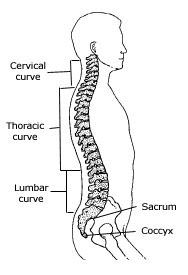When your mother told you to sit up straight at the dinner table she knew what she was talking about. Most of the patients I see these days in the physical therapy clinic suffer from back pain not because of a traumatic injury such as an automobile accident but from years, if not decades, of poor posture and incorrect movement. The first thing I teach them is how to find and maintain a neutral spine posture. So just what is this, and why is it important?
Our backs consist of three small spinal curves—the neck, the mid-back, and the lower back (the lumbar spine). These small curves are essential for shock absorption and to minimize the loads through the entire spine. When we slouch or bend over from our backs (as we often do when we lift something off the floor), we are in a forward flexed position. On the other end of the spectrum, when we backward bend or overarch our spines, such as when we look up at the ceiling, we are in a position of extension.
Keep in mind that our spines should be able to move freely into both flexion and extension along with other motions such as rotation. However, most of the time, we should be in neutral. Sitting slouched over for hours at a time (at a computer) or failing to stand up straight during normal, everyday activities, can seriously compromise the health and flexibility of our spines.
Imagine lifting a 20-pound bag of groceries off the floor and doing so while rounding and twisting your lower back. Better yet, imagine lifting a 40-pound dumbbell off the gym floor doing the same thing. On any given occurrence, it’s no big deal. But after a couple of decades executing this faulty movement, one day your back is going to seize up and spasm. If this has never happened to you, trust me: the pain is excruciating.
The spine is up to 40 percent stronger and more resilient to compressive load when you’re in the neutral spine position. The neutral spine also optimally positions your back muscles to protect your spine. The back muscles attach to our spines on several different angles, much like the cables on a suspension bridge. When the spine is in neutral these muscles can optimally support our mobile spine structure. When we fall out of neutral, they become much less efficient.
So now you know the importance of achieving and maintaining a neutral spine. The next question is, how do you get there? Well, it’s really quite simple. The easiest way to find your neutral spine is to lie flat on your back on an exercise mat, with your knees bent and your feet flat on the floor. Relax your body and allow your back to rest into the floor, without tilting your pelvis. You should be able to fit a finger or two in between your lower back and the floor, but not more than that.
Once you know what a neutral spine feels like, roll up gently from the floor and stand up. Try to maintain the same posture you had on the floor. When you lift weights or groceries or even a child, be sure to lift from this same neutral position, rather than bending over.







Leave a Reply
You must be logged in to post a comment.